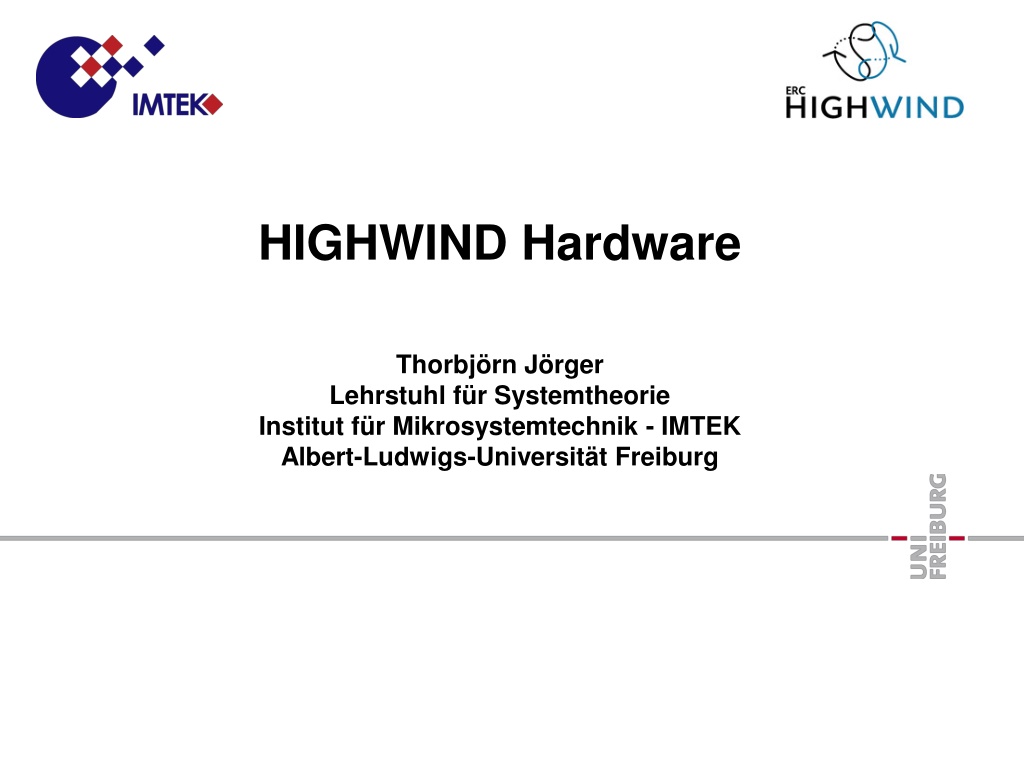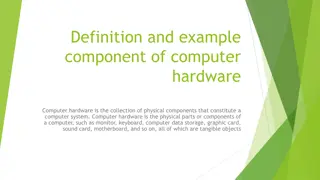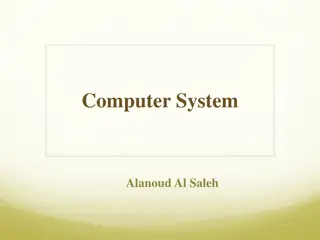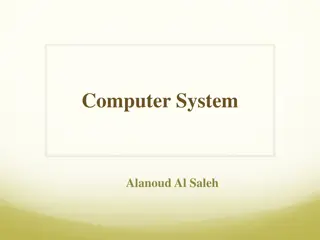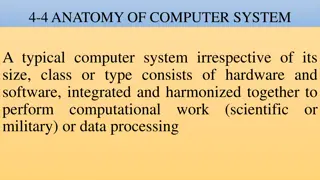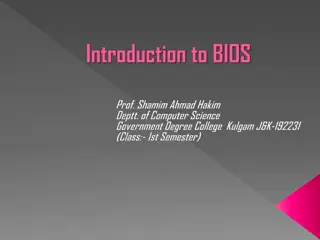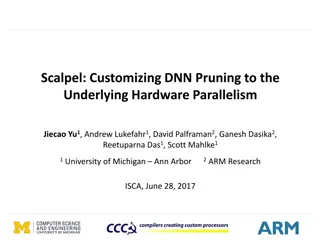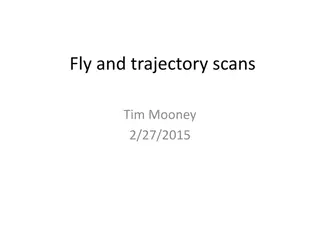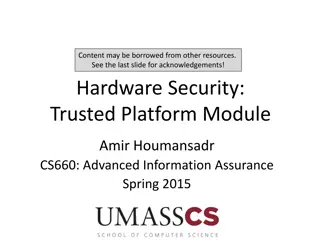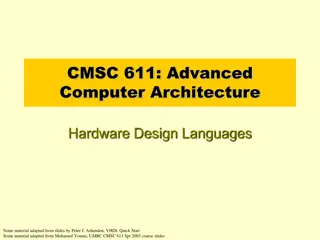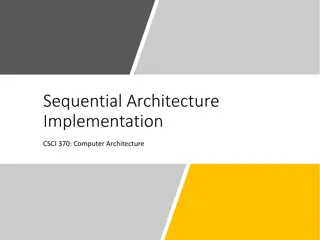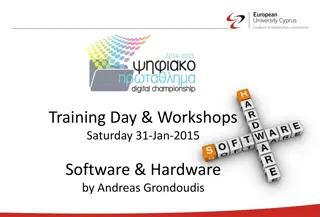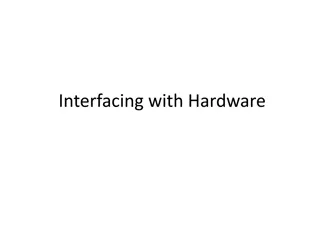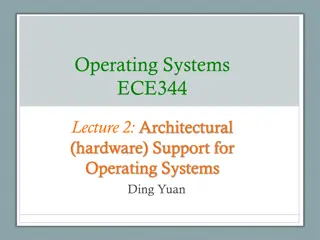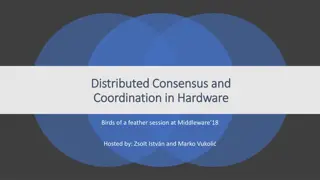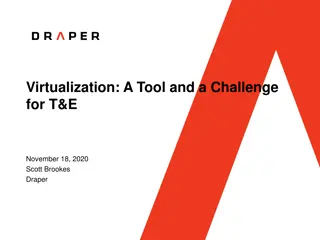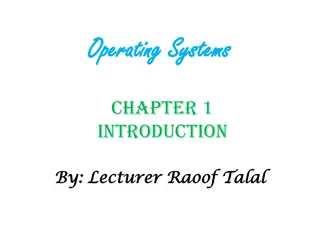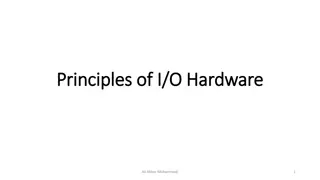HIGHWIND Hardware: Team and Responsibilities Overview
Explore the team and responsibilities behind the HIGHWIND hardware project, involving airplane components, sensors, actuators, communication interfaces, control software, and visualization. Meet the dedicated members working on flight software and hardware, all focused on enhancing communication, safety, and stability for this innovative system.
Download Presentation

Please find below an Image/Link to download the presentation.
The content on the website is provided AS IS for your information and personal use only. It may not be sold, licensed, or shared on other websites without obtaining consent from the author.If you encounter any issues during the download, it is possible that the publisher has removed the file from their server.
You are allowed to download the files provided on this website for personal or commercial use, subject to the condition that they are used lawfully. All files are the property of their respective owners.
The content on the website is provided AS IS for your information and personal use only. It may not be sold, licensed, or shared on other websites without obtaining consent from the author.
E N D
Presentation Transcript
HIGHWIND Hardware Thorbj rn J rger Lehrstuhl f r Systemtheorie Institut f r Mikrosystemtechnik - IMTEK Albert-Ludwigs-Universit t Freiburg
Responsibilities All HIGHWIND hardware Carousel Airplanes Sensors Actuators Components communication and interfacing Interface definition (BETCOM) Implementing communication Control software Carousel (OROCOS) Flight hardware Visualisation - 2 - 12.06.2015 Scientific Advisory Board Meeting 2015 Thorbj rn J rger
Team: Communication & Visualisation Elias Rosch: B. Sc. Embedded Systems Engineering Currently master studies ESE With HIGHWIND since April 2014 Julian Reimer B. Sc. Embedded Systems Engineering Currently master studies ESE With HIGHWIND since December 2014 - 3 - 12.06.2015 Scientific Advisory Board Meeting 2015 Thorbj rn J rger
Team: Flight software Fabian Girrbach B. Sc. Embedded Systems Engineering Currently master thesis ESE With HIGHWIND since April 2014 Maximilian Ernestus B. Sc. Informatik Currently master studies Cognitive Sciences With HIGHWIND since March 2015 - 4 - 12.06.2015 Scientific Advisory Board Meeting 2015 Thorbj rn J rger
Team: Flight hardware Ben Schleusener B. Sc. Microsystems Engineering Currently master studies MST With HIGHWIND since September 2013 Joanna Greulich Currently bachelor studies MST With HIGHWIND since April 2015 - 5 - 12.06.2015 Scientific Advisory Board Meeting 2015 Thorbj rn J rger
Carousel Target: Black Box for users PLC and motor drives Fixed all bugs Hard coded limits for safety Stable communication to Groundstation Clean interface to OROCOS Safety measures implemented Warning lights Speed limits Now: Fire and Forget - 6 - 12.06.2015 Scientific Advisory Board Meeting 2015 Thorbj rn J rger
Rod mounted half-wing airplane Intermediate step to tethered flight Only two degrees of freedom Much easier to control Easy task for testing the setup Hard limits for elevation and rotation No dangerous angles of attack Absolute angular sensors Accurate position over ground But angle of attack is most likely different Reference for state estimation with IMUs Clean interface to OROCOS Black Box for experimenters - 7 - 12.06.2015 Scientific Advisory Board Meeting 2015 Thorbj rn J rger
Sensor fusion It is desirable to have all sensors fused at one point Time keeping and synchronisation much easier Easier to maintain Fast and low jitter connection to controller More time for NMPC calculations in each time step - 8 - 12.06.2015 Scientific Advisory Board Meeting 2015 Thorbj rn J rger
Sensor fusion It is desirable to have all sensors fused at one point Time keeping and synchronisation much easier Easier to maintain Fast and low jitter connection to controller More time for NMPC calculations in each time step Past: - 9 - 12.06.2015 Scientific Advisory Board Meeting 2015 Thorbj rn J rger
Sensor fusion It is desirable to have all sensors fused at one point Time keeping and synchronisation much easier Easier to maintain Fast and low jitter connection to controller More time for NMPC calculations in each time step Present: - 10 - 12.06.2015 Scientific Advisory Board Meeting 2015 Thorbj rn J rger
Sensor fusion It is desirable to have all sensors fused at one point Time keeping and synchronisation much easier Easier to maintain Fast and low jitter connection to controller More time for NMPC calculations in each time step Future: - 11 - 12.06.2015 Scientific Advisory Board Meeting 2015 Thorbj rn J rger
Sensor fusion It is desirable to have all sensors fused at one point Time keeping and synchronisation much easier Easier to maintain Fast and low jitter connection to controller More time for NMPC calculations in each time step Future? - 12 - 12.06.2015 Scientific Advisory Board Meeting 2015 Thorbj rn J rger
Time keeping Each measurement gets a time stamp in a unified time frame From the time stamping on, all delays can be taken into account by the controller and the state estimator System is now calibration free Execution time for actuator commands can be set But need for synchronous clocks - 13 - 29.05.2015 Group Retreat 2015 - Seebrugg - Thorbj rn J rger
Clock synchronization Reference pulse which occurs simultaneous in both systems 1PPS signal of GPS is the natural choice for outdoor experiments no information exchange between systems necessary Absolute and jump-free GPS time reference is also available Small jitter (15-50 ns) with cheap equipment, < 1 ns with better equipment Indoor Environment usually has to low signal strength - 14 - 29.05.2015 Group Retreat 2015 - Seebrugg - Thorbj rn J rger
Clock synchronization Necessary Reference pulse which occurs simultaneous in both systems 1PPS signal of GPS is the natural choice for outdoor experiments no information exchange between systems necessary Absolute and jump-free GPS time reference is also available Small jitter (15-50 ns) with cheap equipment, < 1 ns with better equipment Indoor Environment usually has to low signal strength To much manpower necessary Nice to have - 15 - 29.05.2015 Group Retreat 2015 - Seebrugg - Thorbj rn J rger
Clock synchronization Reference pulse which occurs simultaneous in both systems 1PPS signal generated by BeagleBone Simple and reliant Quick to implement Hardware programming portable for real 1PPS Additional cables necessary (bad for tethered flight) - 16 - 29.05.2015 Group Retreat 2015 - Seebrugg - Thorbj rn J rger
BETPROT: Overview Clean message based interface between all components Defines messages containing data, controls and configuration Based on protobuf, which is already used in OROCOS High flexibility through platform and protocol independence - 17 - 29.05.2015 Group Retreat 2015 - Seebrugg - Thorbj rn J rger
BETPROT: Messages Messages are defined as either: Required (exactly one message of this type required per packet) Optional (zero or one message of this type contained per packet) Repeated (zero to multiple messages of this type contained per packet) This allows high flexibility, sensors can be added, cconfigured or neglected easily Messages can be nested: msg BETPROTO: required msg BETCALL required uint32 pps required uint32_t ticks repeated msg Airspeed required uint32_t pps required uint32_t ticks required uint32_t airspeed_raw optional uint32_t debug_info msg BETPUSH - 18 - 29.05.2015 Group Retreat 2015 - Seebrugg - Thorbj rn J rger
HIGHWIND Communication and Visualisation Elias Rosch, Julian Reimer Lehrstuhl f r Systemtheorie Institut f r Mikrosystemtechnik - IMTEK Albert-Ludwigs-Universit t Freiburg
Protocol: BetProt Flight- control Communication between Groundstation and BB BB Sensors Sensors Actuators via Ethernet / TCP Communication Framework ZMQ Messages defined via Google Protobuf: BetCall contains Sensordata BetPush contains Actuatordata BetCall BetPush GS BetCall Receiver Sender Visualizer Actuatorcontainer Sensorcontainer OROCOS - 20 - 12.06.2015 Scientific Advisory Board Meeting 2015 Elias Rosch, Julian Reimer
BetCall Message generated by BB Submessages contain: Values for different axes Timing information Receiver Forwards messages to visualizer unpacks messages into the datastructure Sensorcontainer OROCOS handles Sensorcontainer IMUs plane IMUs arm Gps Line angle Airspeed Angle of attack Dms Timestamp Ticks - 21 - 12.06.2015 Scientific Advisory Board Meeting 2015 Elias Rosch, Julian Reimer
BetPush Message generated by GS OROCOS fills Actuatorcontainer Sender packs messages from Actuatorcontainer Flaps Ailerons Rudder Elevator Ticks - 22 - 12.06.2015 Scientific Advisory Board Meeting 2015 Elias Rosch, Julian Reimer
BetVisualizer Receives BetCall messages Generates visual feedback from current sensor- and timingdata IMU plane IMU arm Line angle - 24 - 12.06.2015 Scientific Advisory Board Meeting 2015 Elias Rosch, Julian Reimer
HIGHWIND Flight software Fabian Girrbach, Maximilian Ernestus Lehrstuhl f r Systemtheorie Institut f r Mikrosystemtechnik - IMTEK Albert-Ludwigs-Universit t Freiburg
Sensing setup - 26 - 12.06.2015 Scientific Advisory Board Meeting 2015 Fabian Girrbach, Maximilian Ernestus
Why two frameworks? Paparazzi - Rich features for autonomous flying - Open source project with many experts involved - Dependencies between modules have to be considered - More complex code structure and debugging Arduino - Rich library and example database - Multi-purpose and multi- solution - In general lower quality of code - Focus on simplicity instead of performance Framework Pros: Learning Curve: - 27 - 12.06.2015 Scientific Advisory Board Meeting 2015 Fabian Girrbach, Maximilian Ernestus
HIGHWIND Flight hardware Ben Schleusener, Joanna Greulich Lehrstuhl f r Systemtheorie Institut f r Mikrosystemtechnik - IMTEK Albert-Ludwigs-Universit t Freiburg
Delay overview Standard ethernet is a bad choice for real time applications - 29 - 12.06.2015 Scientific Advisory Board Meeting 2015 Ben Schleusener, Joanna Greulich
Delay overview Common time base is needed Beaglebone generates 1PPS-signal - 30 - 12.06.2015 Scientific Advisory Board Meeting 2015 Ben Schleusener, Joanna Greulich
Derivation of time from 1PPS 1PPS pulses are numbered consecutively Intervals between 1PPS are counted with 8 MHz (ticks) 125 s resolution On rising flag, pulse counter is incremented and tick counter reset Time stamp consist of ticks and pulse number The pulse number is referenced in the GS to UTC time frame The GS then calculates absolute timestamps for the measurements - 31 - 12.06.2015 Scientific Advisory Board Meeting 2015 Ben Schleusener, Joanna Greulich
Challenge Helvetica 28 pt You can also put pictures here if they have the appropriate for Helvetica is attached, otherwise use Arial and tell me, I will change it then (Arial is Helveticas bastard son just by the way xD) PW: mjolnir111!%%mjolnir - 32 - 12.06.2015 Scientific Advisory Board Meeting 2015 Ben
